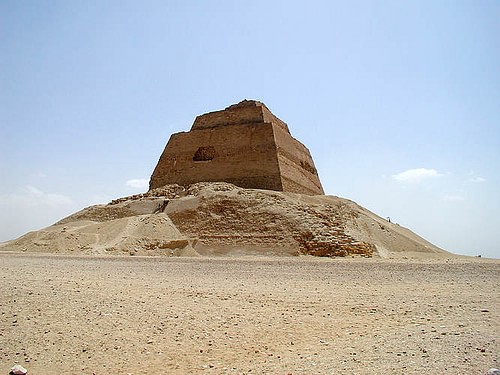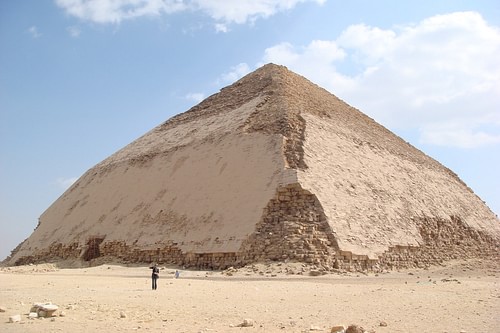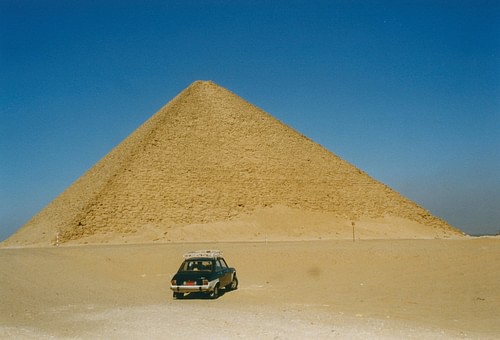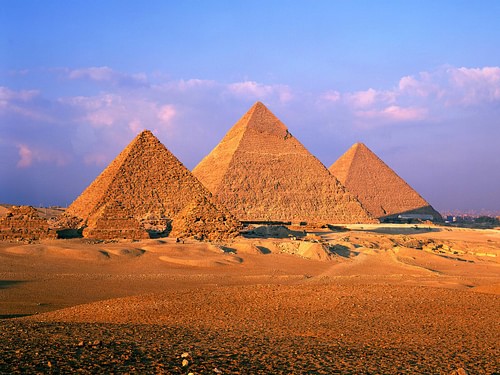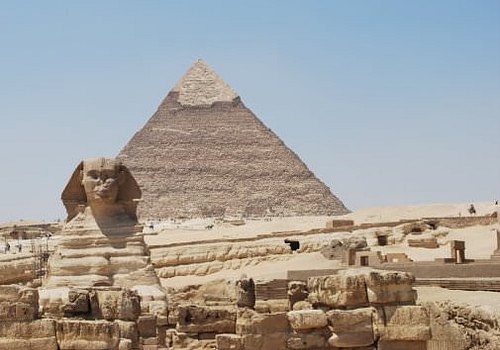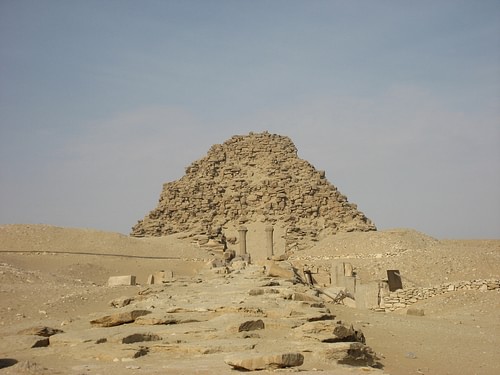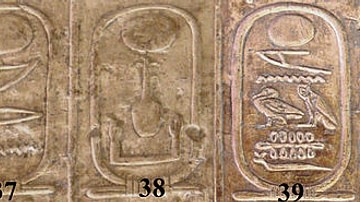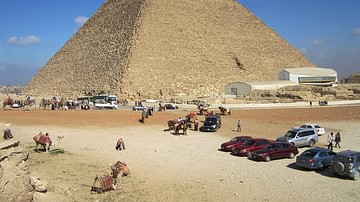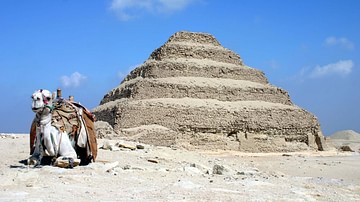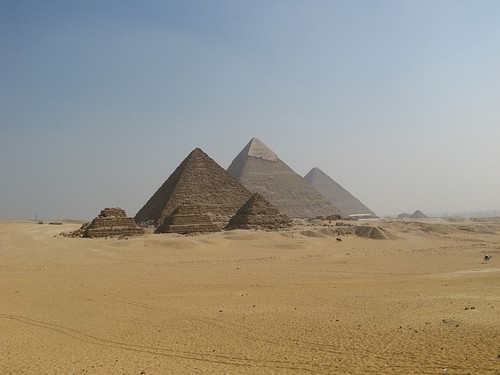
The Old Kingdom of Egypt (c. 2613-2181 BCE) is also known as the 'Age of the Pyramids' or 'Age of the Pyramid Builders' as it includes the great 4th Dynasty when King Sneferu perfected the art of pyramid building and the pyramids of Giza were constructed under the kings Khufu, Khafre, and Menkaure.
The historical records of this period, the 4th-6th Dynasties of Egypt, are scarce and historians regard the history of the era as literally 'written in stone' and largely architectural in that it is through the monuments and their inscriptions that scholars have been able to construct a history. The pyramids themselves relay scant information on their builders, but the mortuary temples built nearby and the stelae which accompanied them provide king's names and other important information.
Further, inscriptions in stone found elsewhere from the time record various events and the dates on which they occurred. Finally, the tomb of the last king of the 5th Dynasty, Unas, provides the first Pyramid Texts (elaborate paintings and inscriptions inside the tomb) which shed light on the religious beliefs of the time.
The pyramids, though, are primarily what the Old Kingdom is most famous for. Historian Marc van de Mieroop writes how the Old Kingdom is "possibly unparalleled in world history for the amount of construction they undertook" (52). The pyramids at Giza, and elsewhere, during this period required unprecedented bureaucratic efficiency to organize the labor force which built the pyramids, and this bureaucracy could only have functioned under a strong central government. Van de Mieroop continues:
Most of the 20-some kings compelled thousands of laborers to quarry, transport, put in place, and decorate vast quantities of stone in order to construct royal mortuary monumnets. They diverted enormous resources from the entire country for this purpose, filling a 70-kilometer-long stretch of the desert edge along the west bank of the Nile near modern Cairo with huge monuments still awe-inspiring today despite the ravages of time. (52)
The 4th Dynasty of the Old Kingdom was a time of progress and a strong centralized government which could command the kind of respect necessary for such building projects. During the 5th and 6th Dynasty, however, the priesthood began to grow in power, primarily through their hold over the very mortuary practices which gave rise to the great pyramids, empowering the local officials of the districts and the kingship suffered. The Old Kingdom began to collapse as more and more local governors assumed more power over their regions, and the central government at Memphis was increasingly seen as irrelevant.
At the end of the 6th Dynasty, there was no longer a central government of note and Egypt entered a period of social unrest and reformation known as The First Intermediate Period (2181-2040 BCE) during which Egypt was ruled regionally by local magistrates who made and enforced their own laws.
The rise of these local officials and the power of the priesthood were not the only causes of the collapse of the Old Kingdom, however, in that a severe drought toward the end of the 6th Dynasty brought famine which the government could do nothing to alleviate. Scholars have also pointed to the exceptionally long reign of Pepi II of the 6th Dynasty as a contributing factor because he outlived his successors and left no heir to the throne.
Many scholars today no longer see the end of the Old Kingdom as a 'collapse' so much as a transition to the new paradigm of the First Intermediate Period, when local rulers governed their districts directly and the kind of wealth previously only available to nobility became more widespread. The long-standing designation of a political and cultural collapse at the end of the 6th Dynasty is still considered viable, however, in that the central government's loss of power and wealth led directly to the regional rule of the district nomarchs.
The Third Dynasty & the Old Kingdom
The name 'Old Kingdom' was coined by archaeologists in the 19th century CE in an attempt to demarcate Egypt's long history. The Egyptians themselves did not refer to this period by that name and would have seen no difference between the period which preceded or succeeded it. Scholars traditionally included the Third Dynasty of Egypt (c. 2670-2613 BCE) in the period of the Old Kingdom because of the Pyramid of King Djoser at Saqqara, the first pyramid ever built in Egypt, seemed to link that dynasty to the building efforts of the 4th Dynasty, because the last king of the Third Dynasty was related to the first king of the 4th, and because Djoser and his successors ruled from Memphis ("the white walls") which remained the capital during the Old Kingdom. Recent scholarship, however, rejects that view as the construction of Djoser's pyramid is more in keeping with the Early Dynastic Period in Egypt (c. 3150-2613 BCE) than the Old Kingdom as are cultural practices and observances.
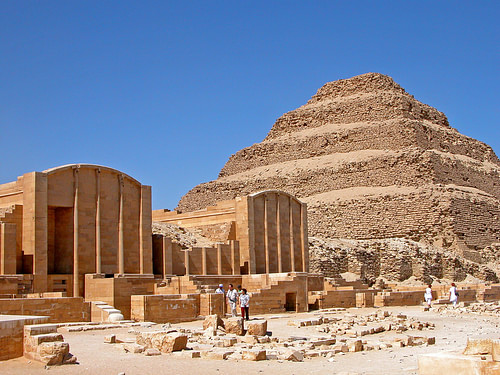
Djoser's architect Imhotep (c. 2667-2600 BCE) revolutionized construction in Egypt by building the king's tomb at Saqqara out of stone. Prior to Imhotep's innovation, tombs and other structures were built of mud brick. The early tombs of Egypt were mud brick mastabas, but Imhotep wanted a lasting memorial to his king and so created a complex with a stone pyramid as its center and surrounding temples; thus inventing the paradigm which would be followed by every dynasty which followed to greater or lesser degrees.
Further, it was during the Third Dynasty that the independent states of the country came to be known as nomes (districts) directly under the rule of a centralized government at Memphis. These developments in architecture, politics, and also in religious practices - all a departure from the past - made it clear to Egyptologists that the Third Dynasty was the beginning of a new period in Egypt's history and should be included in the Old Kingdom rather than the Early Dynastic Period.
Today, however, scholars see the Third Dynasty as a transitional phase more closely linked to the earlier period than the latter. Even though Djoser's pyramid of stone was a wholly new creation it still utilized Early Dynastic Period techniques. The pyramid at Saqqara is actually a stack of mastabas rather than a true pyramid and, regarding the political reforms and creation of nomes, the central government of the Third Dynasty did not have the reach nor command the resources of the 4th Dynasty. For these reasons and others, the Old Kingdom is now thought to begin with the 4th Dynasty of Egypt, although, it should be noted, this claim is not at all universally accepted among scholars.
The First True Pyramid
The last king of the Third Dynasty, Huni (c. 2630-2613 BCE), was long thought to have initiated the massive building projects of the Old Kingdom in constructing the pyramid at Meidum, but credit for the Meidum pyramid goes to the first king of the 4th Dynasty, Sneferu (c. 2613-2589 BCE) who may have been Huni's son by one of his minor queens. Egyptologist Barbara Watterson writes, "Sneferu initiated the golden age of the Old Kingdom, his most notable achievements being the two pyramids built for him at Dahshur" (50-51). Sneferu began his work with the pyramid at Meidum now referred to as the "collapsed pyramid" or, locally, as the "false pyramid" because of its shape: it resembles a tower more than a pyramid and its outer casing rests around it in a gigantic heap of gravel.
The pyramid of Meidum is the first true pyramid constructed in Egypt but did not last. This is because modifications were made to Imhotep's original pyramid design which resulted in the outer casing resting on a sand foundation rather than rock, causing it to collapse. Scholars are divided on whether the collapse occurred during construction or over a longer period of time. Egyptologist Miroslav Verner cites the work of the archaeologist Borchardt in claiming that the pyramid was built in stages, which increasingly had the outer foundation resting on sand while the inner foundation was securely built on rock.
When the workers reached the third stage of the building process, the outer casing, the structure lacked cohesion because it had no firm footing "with the result that during the final phase of construction a massive slippage buried the workers under the rubble" (162). Other scholars, however, disagree and claim that the outer casing lasted into the New Kingdom of Egypt (c. 1570 - c. 1069 BCE). Still others, like historian Marc van de Mieroop, claim that it is impossible to tell when the outer casing collapsed.
Unfinished temples and other structures have been found at Meidum which suggest that the pyramid complex was never finished and so argue for an early collapse of the pyramid, most likely while it was still under construction. Sneferu learned from his mistake, however, and moved on to his next two pyramids at Dahshur.
King Sneferu & His Pyramids
Sneferu's pyramids at Dahshur are known as the Bent Pyramid and the Red Pyramid (or North Pyramid). The Bent Pyramid is so called because it rises at a 55-dgree angle and then shifts to 43 degrees of smaller stones giving it the appearance of bending in toward the top. The workers had completed the foundation and the sides before realizing that a 55-degree angle was too steep and modified their plan to finish the project as best they could. Sneferu seems to have understood the problem and moved on to build his third pyramid.
According to inscriptions on the Palermo Stone, Sneferu was a much-admired king, who commanded great respect from his people. Barbara Watterson, commenting on the Palermo Stone inscriptions, writes:
He led military expeditions to Sinai to protect Egypt's interests in the turquoise mines, and to northern Nubia and Libya, bringing back from Nubia 7,000 prisoners and 200,000 head of cattle and, from Libya, 11,000 prisoners and 13,100 head of cattle. The prisoners were probably used to augment the work-force in quarries. In succeeding generations, Sneferu acquired the reputation of being beneficent and liberal and, according to a story recounted in the Westcar Papyrus, capable of the common touch in addressing one of his subjects as 'my brother.' (51)
Sneferu seems to have been a very accessible ruler who was undeterred by failure or disappointment. When the Bent Pyramid did not meet his expectations he simply started on a third attempt. The Red Pyramid (so called because of the use of reddish limestone in construction) was built on a solid base for greater stability, rising at a 43-degree angle. 344 feet (105 meters) high, the Red Pyramid was the first successful true pyramid built in Egypt. Originally it was encased in white limestone, as the other later pyramids were also, which fell away over the centuries and were harvested by locals for other building projects.
King Sneferu, through his military expeditions and judicious use of resources, established a powerful central government at Memphis which produced the kind of stability necessary for his vast building projects. Following the example of Djoser's complex at Saqqara, Sneferu had mortuary temples and other buildings constructed around his pyramids with priests taking care of the day-to-day operations once the Red Pyramid was finally completed. All of this argues for a stable society under his reign which he left to his son, Khufu, when he died.
Khufu & the Great Pyramid
Khufu (2589-2566 BCE) was known as Cheops by the ancient Greek writers and is best known for his Great Pyramid at Giza. The Greeks depicted him as a tyrant in their writings who oppressed the people and forced them to work for him against their will. This impression may have been made by the stories which make up the document known as the Westcar Papyrus, a collection of four stories written about the kings of the 4th Dynasty and discovered (or obtained from an antiquities dealer) in c. 1824 CE by Henry Westcar.
The papyrus features four stories told by sons of Khufu and includes one where King Khufu calls a magician to court who claims to be able to reattach a severed head to a body, and some scholars have interpreted his actions in asking for a demonstration as cruel or thoughtless. According to Barbara Watterson, "the Westcar Papyrus portrays him as careless with life" and other inscriptions show him as "oppressive and autocratic" (51). In the story of the magician and the severed head, however, Khufu seems mostly skeptical of the seer's abilities, and the other stories, though related by Khufu's sons or successors, have to do with other kings. The Westcar Papyrus gives no indication that Khufu was a tyrant or oppressive in any way.
Most likely, the ancient Greeks who wrote of "Cheops" as a tyrant took their lead from Herodotus, who writes that Khufu brought to Egypt "every kind of evil" for his own glory, forcing "a hundred thousand men at a time, for three months continually" to work on his pyramid (II.124). Further, Herodotus claims, Khufu was so in need of money that he sent his daughter to work in the brothels of Memphis and demand a high price for her services (II. 124). His claims have been discredited through Egyptian texts, which praise Khufu's reign, and physical evidence, which suggests the workers on the Great Pyramid were well cared for and performed their duties as part of a community service, as paid laborers, or during the time the Nile's flood made farming impossible. Scholars Bob Brier and Hoyt Hobbs note:
Were it not for the two months every year when the Nile's water covered Egypt's farmland, idling virtually the entire workforce, none of this construction would have been possible. During such times, a pharaoh offered food for work and the promise of a favored treatment in the afterworld where he would rule just as he did in this world. For two months annually, workmen gathered by the tens of thousands from all over the country to transport the blocks a permanent crew had quarried during the rest of the year. Overseers organized the men into teams to transport the stones on sleds, devices better suited than wheeled vehicles to moving weighty objects over shifting sand. A causeway, lubricated by water, smoothed the uphill pull. No mortar was used to hold the blocks in place, only a fit so exact that these towering structures have survived for 4,000 years - the only Wonders of the Ancient World still standing today. (17-18)
The Great Pyramid, actually, is the only one of the structures at Giza which was considered one of the ancient Seven Wonders of the World and with good reason: until the Eifel Tower was completed in 1889 CE, the Great Pyramid was the tallest structure on earth built by human hands. Historian Marc van de Mieroop writes:
The size boggles the mind: it was 146 meters high (479 feet) by 230 meters at the base (754 feet). We estimate that it contained 2,300,000 blocks of stone with an average weight of 2 and 3/4 tons some weighing up to 16 tons. Khufu ruled 23 years according to the Turin Royal Canon, which would mean that throughout his reign annually 100,000 blocks - daily about 285 blocks or one every two minutes of daylight - had to be quarried, transported, dressed, and put in place...The construction was almost faultless in design. The sides were oriented exactly toward the cardinal points and were at precise 90-degree angles. (58)
However Herodotus and the later Greeks viewed Khufu, his people admired him. During his reign, Egypt grew even more wealthy through his military campaigns against Nubia and Libya and his very prosperous trade agreements with cities such as Byblos. He also devoted resources to improving the lives of his subjects through agricultural innovations. Miroslav Verner writes, "during his reign the earliest known dam in the world was built in Wadi Gerawi, in the mountains west of modern Helwan" (155). This dam aided the farmers and others in the community by improving the water supply.
Although Memphis remained the capital of Egypt during Khufu's reign, he most likely lived in a palace at Giza to oversee the work on the Great Pyramid himself. In order to maintain maximum efficiency in government and waste as little time as possible, he gave the greatest amount of power to his most trusted family members, who must have been pleased with the arrangement as there is no record of internal strife during his rule.
Khafre, The Sphinx, & Menkaure
After Khufu's death, he was succeeded by a family member outside the legitimate line named Djedefre (2566-2558 BCE). Verner notes that early Egyptologists considered the destruction of this king's pyramid complex in Abu Rawash to be evidence of internal family strife but, actually, the "intensive devastation began in Roman times, when the monument degenerated into a stone quarry" and the Romans used the stone for other building projects (156). Djedefre was certainly Khufu's son, but it seems he was not his chosen successor. Theories regarding family conspiracies against him, however, appear unfounded.
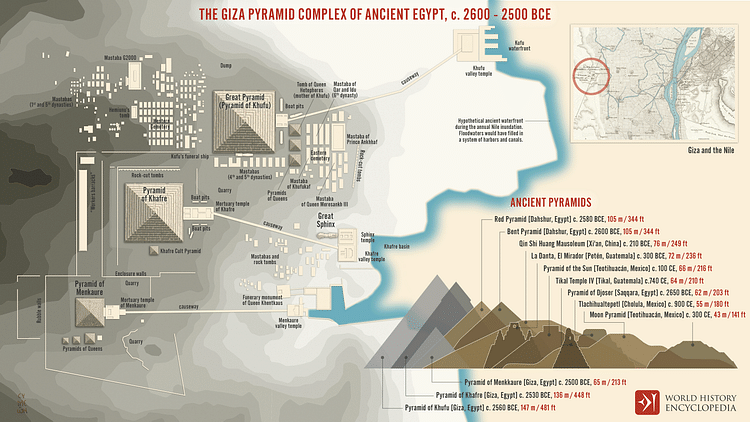
The most important aspect of Djedefre's reign, however, is not his pyramid or the claim that he built the Sphinx but his association of the position of king with the cult of the sun god Ra. He was the first king of Egypt to apply the title "Son of Ra" to himself marking the kingship as subordinate to the sun god. In the Second Dynasty, king Raneb had linked his name to the gods and so established the king as the gods' representative on earth, the living embodiment of the gods. After Djedefre's reform, the king would still be seen as a divine representative but now in a more subordinate position as a child of god.
Djedefre is considered by some scholars (such as Dobrev in 2004 CE) the creator of the Great Sphinx of Giza while others attribute this monument to his brother, and successor, Khafre (2558-2532 BCE). The Sphinx is the largest monolithic statue in the world depicting a reclining lion's body with the head and face of a king. Traditionally this king's face is accepted as Khafre, but Dobrev and others claim it may actually be Khufu's. It seems likely that it was created by Khafre since it is perfectly in line with his pyramid complex and the Sphinx's face seems to resemble Khafre's more than Khufu's. Brier and Hobbs write:
Khafre's pyramid rises even higher than its famous neighbor, although it actually stood ten feet shorter when it was new. Its gleaming casing of white limestone, transported by boats from quarries across the Nile, still covers the top, laid over interior limestone blocks which were cut from the surrounding Giza site. Probably in the course of freeing these interior blocks, quarrymen struck a seam of harder rock they avoided, leaving a small hill. Khafre had this outcrop carved in the shape of a recumbent lion bearing his own face - the famous Sphinx. (16)
The pyramid of Khafre is the second-largest at Giza and his complex almost as grand as his father's. Little is known of his reign but the Greeks (who called him Chephren) viewed him just as they had his father: as a tyrant who oppressed his people in the interests of building his grand mortuary monument. Egyptian texts indicate he followed his father's policies and model of government in placing power in the hands of his closest family members and maintaining a tight control over policies and laws.
Khafre associated himself with the god Horus (as earlier kings had done), and the Sphinx was considered an image of the king as the god Harmakhet ('Horus in the Horizon'). Unlike the kings of the Early Dynastic Period, however, Khafre - and those who came after him - referred to himself as a "Son of Horus", associated with the god but not the living god himself. The power of interpreting the will of the gods, though still within the king's sphere of influence, grew increasingly the provenance of the priests who served those gods.
Following Khafre's death, succession was again interrupted briefly when Baka, son of Djedefre, took the throne. He did not even reign a year, however, before Menkaure (2532-2503 BCE), Khafre's son, became king. Menkaure (known as Mykerinos by the Greeks) is viewed favorably by both the Greeks and the Egyptian texts. Like his father and grandfather before him, Menkaure began building his pyramid and temple complex at Giza.
Although today the Giza plateau is an ancient sand-swept site on the outskirts of Cairo, in the time of Menkaure it was a city of the dead inhabited by the living who cared for it. Priests' homes, temples, workmen's housing, shops, factories, breweries, and all the aspects of a small city were present at Giza.
Contrary to the popular belief that the pyramids of Giza were built by slave labor (specifically Hebrew slave labor), they were actually constructed by Egyptians, many of whom were highly skilled workers who were paid for their time. The pyramids are thought to represent the primordial mound, the ben-ben, which first rose from the waters of chaos at the beginning of creation. Although slave laborers from Nubia, Libya, even Canaan and Syria, were most likely used in the quarries cutting rock or in the gold mines, they would not have been entrusted to create the king's eternal home in the image of the first earth to rise from the waters.
No slave quarters have been discovered at Giza and no Egyptian records relate any event such as that set down in the biblical Book of Exodus. Workmen's quarters, supervisor's houses, overseer's homes have all been found and make clear that the work done at the Giza plateau in the Old Kingdom was performed by Egyptians working for compensation.
Menkaure's pyramid and complex is smaller than the other two and this signifies an important development in the history of the Old Kingdom and one of the reasons why it would collapse. The resources necessary for the building of the Great Pyramid were no longer available in Menkaure's time but he still drew on what he could to create an eternal home on par with his father's and grand-father's.
Menkaure's son and chosen successor, Khuenre, died while the pyramid was being built, which upset the dynastic succession, and Menkaure himself died before the pyramid complex was completed. Although he reigned for some thirty years, he was not able to complete what his predecessors had done, and to many scholars (Verner and Watterson among them) this signifies the dwindling resources at his command. His successor, Shepseskaf (2503-2498 BCE), completed Menkaure's complex at Giza but was himself buried in a fairly modest mastaba at Saqqara.
The kings, as previously noted, were diverting enormous resources to their mortuary monuments and complexes, but these temples and shrines were increasingly no longer under the king's control but that of the priests who administered them. After Shepseskaf's brief reign the 4th Dynasty came to an end and the 5th began with much less promise than when Sneferu had succeeded Huni.
The 5th & 6th Dynasties & Collapse
It was Sneferu who had first associated his dynasty with the solar cult of the god Ra, but it was Djedefre who reduced the status of the king from a living god to the son of that god. The priests grew in power at the expense of the throne but, still, the king was the representative of the gods on earth and commanded respect and power. Exactly how much respect and power was waning, however.
The 5th Dynasty is known as the dynasty of the Sun Kings because the names of so many have the god Ra's name in them (usually given as Re). The first three of these kings (Userkaf, Sahure, and Kakai) would later be honored as divinely appointed in the story The Birth of the Kings from the Westcar Papyrus. The dynasty begins with the king Userkaf (2498-2491 BCE), but a woman named Khenkaues, most probably a daughter of Menkaure, features largely in the inscriptions of the time as "Mother of Two Kings of Upper and Lower Egypt" though it is unknown who those kings were. Her tomb is the fourth pyramid at Giza, and she was obviously a very important figure, but little is known of her.
Userkaf is best known for the construction of the Temple of the Sun at Abusir. This building marks an important departure from the role of the king at the beginning of the 4th Dynasty and the beginning of the end of Giza as the necropolis of the kings. The sun god Ra was now worshiped directly by the people through the offices of the priesthood and the king's role as direct representative of the god was diminished. Barbara Watterson comments on this:
In the Fourth Dynasty one of the components of the royal titulary, the nsw-bit (King of Upper and Lower Egypt) name was occasionally written inside a cartouche, thereby signifying that the king ruled over everything that the sun's disc, or Ra, encircled. The use of the cartouche became normal in the Fifth Dynasty, when kings adopted the title "Son of Ra". In previous dynasties, kings were deemed to be the earthly manifestation of the god Horus; but, in adding the new title to the royal titulary, they reduced their status from god to son of god. The king's divine authority was further eroded in the Fifth Dynasty when temples were erected at pyramid sites not, as before, for the worship of the king, but for the celebration of the cult of Ra. (52)
Userkaf was succeeded by his son Sahure (2490-2477 BCE) who built his mortuary complex at Abusir near the Temple of the Sun. Sahure was an efficient ruler, who organized the first Egyptian expedition to the Land of Punt and negotiated important trade agreements with other nations. Punt was among his greatest achievements, however, as it would become an important source of many of Egypt's most prized resources and, in time, regarded as a mythical land of the gods.
Sahure built his own Temple to the Sun at Abusir and was the first to make use of the palmiform columns in architecture which would become standard for columns throughout Egypt from then on (the well-known columns whose tops are shaped like palm fronds). Sahure's military expeditions and prudent use of resources enriched the country as evidenced by the elaborate work done on his mortuary complex and inscriptions found.
He was succeeded by his son Neferirkare Kakai (2477-2467 BCE). Inscriptions indicate he was a good king and well respected, but little is known of his reign except that the priesthood grew even more powerful during his rule. His son, Neferefre (2460-2458 BCE), succeeded him but died a short time into his reign, probably around the age of 20. The king Shepsekare succeeded him, but nothing is known of his reign.
He is succeeded by Nyussere Ini (2445-2422 BCE) during whose reign the priests of Ra gained even more power. The bureaucracy of the temples and mortuary complexes also increased, which placed increasing strains on the royal treasury which paid for the temple's upkeep and maintenance. The king Menkauhor Kaiu (2422-2414 BCE) succeeded him, but very little is known of his reign except that he was the last king to build a Temple to the Sun. He was succeeded by Djedkare Isesi (2414-2375 BCE).
Djedkare Isesi's origins are unknown. He is not considered the son of Menkauhor Kaiu but could have been related. His reign is marked by extensive reformation of the bureaucracy and the priesthood in an effort to maintain a stable economy. Djedkare Isesi rejected the traditional practice of building a temple to the sun god and reduced the number of priests necessary for the maintenance of mortuary complexes. He also organized the second expedition to Punt which enriched Egypt and further strengthened ties with Punt.
It is possible that Djedkare Isesi's departure from the cult of the sun god had to do with the development of the Osiris cult and their emphasis on eternal life through association with the god who had died and returned to life. Although the Osiris cult would not become popular until the period of the Middle Kingdom of Egypt (2040-1782 BCE), evidence strongly suggests that this former agricultural deity was already associated with death and resurrection during the Old Kingdom. The fact the Djedkare Isesi was venerated by his own cult for centuries after his death would support this claim. The Osiris cult eventually became more widespread and much more popular than the cult of Ra and Djedkare Isesi, as an early royal adherent of the cult, would have commanded great respect from later members.
The most significant aspect of Djedkare Isesi's reign, however, was the decentralization of the government at Memphis which placed greater power in the hands of local officials. This was done to lessen the costs of the massive bureaucracy which had grown up during the 4th and earlier 5th Dynasties. Although the idea might have made sense, it essentially gave more power to the regions where local priests were already influential enough to order governmental administrators about and so made the king's earlier efforts at curtailing priest's power almost irrelevant.
Djedkare Isesi was succeeded by his son Unas (2375-2345 BCE) about whose reign little is known. Unas was the first king of Egypt to have the interior of his tomb painted and marked with inscriptions which have come to be known as the Pyramid Texts. These inscriptions show the king in communion with Ra and Osiris which lends further support to the claim that Djedkare Isesi was influenced by the cult of Osiris in reforming the priesthood of Ra in that the king who succeeded him (Unas) placed the two gods on equal footing in his tomb.
The 6th Dynasty Decline & Collapse
When the 6th Dynasty began, the role of the king was already greatly diminished. During the reign of the first king, Teti (2345-2333 BCE), local officials and administrators were building more elaborate tombs than nobility. According to the 3rd-century BCE historian Manetho, Teti was murdered by his bodyguards, a crime which would have been unthinkable previously. He was succeeded by Userkare (2333-2332 BCE), who may have been behind the plot to assassinate the king.
His reign was short, and he was then succeeded by Meryre Pepi I (2332-2283 BCE) under whose reign the nomarchs (local administrators of the nomes) became more powerful. This trend continued with the reign of Merenre Nemtyensaf I (2283-2278 BCE) and into that of Neferkare Pepi II (2278-2184 BCE), who came to the throne as a child and died as an old man, marking an incredible reign of close to a hundred years.
In the long reign of Pepi II, the Old Kingdom steadily collapsed. The growing power of provincial nomarchs along with the priesthood eroded the authority of the central government and king. Barbara Watterson writes:
Towards the end of the Sixth Dynasty, royal power declined rapidly, due largely to the unsustainable charge on the royal exchequer of maintaining the funerary monuments of previous kings and making gifts to nobles of mortuary equipment and endowments of offerings. The endowing of mortuary priests who served increasing numbers of tombs transferred wealth away from the king to the priesthood. At the same time, the power of provincial governors gew until they became barons of their own fiefdoms. (52)
Pepi II was followed by Merenre Nemtyemsaf II (c. 2184 BCE) with a very short reign, and the dynasty ended with Netjerkare (also known as Neitiqerty Siptah, 2184-2181 BCE) who is identified by some scholars and Egyptologists (such as Percy E. Newberry and Toby Wilkinson) as the Queen Nitocris from Herodotus' account (Histories, Book II.100) of an Egyptian queen who avenges her brother's murder by drowning his killers at a banquet. Newberry offers especially convincing evidence that Herodotus' report, considered by many a myth, is accurate even though there is no Egyptian record of such an event.
Pepi II had outlived any successors to the throne and, in his later years, appears to have been a fairly ineffective king. When a drought brought famine to the land, there was no longer any meaningful central government to respond to it. The Old Kingdom ended with the 6th Dynasty as no strong ruler came to the throne to lead the people. Local officials took care of their own communities and had no resources, nor felt the responsibility, to help the rest of the country. As the 6th Dynasty passed away, Egypt slowly tumbled into the era now classified by scholars as the First Intermediate Period.
